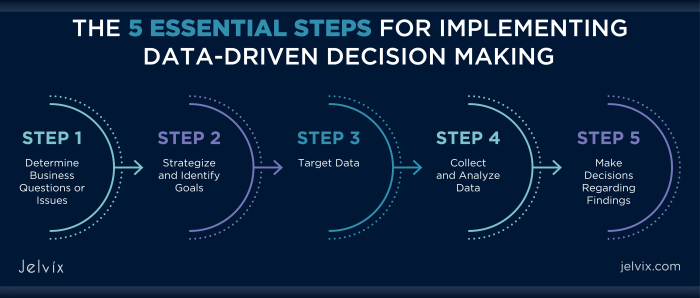Data-Driven Decision Making sets the stage for smarter choices in business, leveraging insights to drive success and efficiency. Dive into the realm of data-driven strategies and unlock the potential for organizational growth.
Exploring the key components and challenges, this discussion sheds light on the power of informed decision-making rooted in data analysis and interpretation.
Importance of Data-Driven Decision Making

Data-driven decision making is crucial in today’s business landscape as it allows organizations to make informed choices based on concrete evidence rather than intuition or guesswork. By analyzing data, businesses can identify trends, patterns, and insights that can drive strategic decisions and ultimately lead to improved outcomes.
Enhanced Efficiency and Effectiveness
- Through data-driven decision making, businesses can optimize their operations by identifying inefficiencies, streamlining processes, and allocating resources more effectively.
- For example, a retail company analyzing sales data may discover that certain products have a higher demand during specific seasons. By adjusting their inventory levels accordingly, they can prevent stockouts and maximize profits.
- By leveraging data to understand customer preferences and behavior, businesses can tailor their marketing strategies to target the right audience with personalized messages, leading to increased customer engagement and sales.
Improved Strategic Planning
- Data-driven decision making enables organizations to forecast future trends, anticipate market changes, and identify new opportunities for growth.
- For instance, a technology company analyzing market data may realize a growing demand for a particular type of software. By investing in research and development in that area, they can stay ahead of competitors and capitalize on emerging trends.
- By continuously monitoring key performance indicators and metrics, businesses can assess their progress towards strategic goals, make adjustments as needed, and ensure long-term success.
Enhanced Decision-Making Process
- When decisions are based on data rather than gut feelings, organizations can reduce the risk of errors, biases, and costly mistakes.
- By using data analytics tools to process large volumes of information quickly and accurately, businesses can make timely decisions that are backed by evidence and analysis.
- Data-driven decision making fosters a culture of transparency and accountability within an organization, as decisions can be traced back to data sources and methodologies, promoting trust and credibility.
Key Components of Data-Driven Decision Making
Data-driven decision making involves several key components that are essential for effective decision-making processes. These components play a crucial role in ensuring that decisions are based on reliable data and analysis, leading to better outcomes.
Data Collection and Analysis
Data collection is the first step in the data-driven decision-making process. It involves gathering relevant information from various sources, such as surveys, databases, and sensors. The collected data is then analyzed to identify patterns, trends, and correlations that can provide valuable insights for decision-making. Effective data analysis requires the use of statistical tools and techniques to interpret the data accurately and derive meaningful conclusions.
Data Quality and Integrity, Data-Driven Decision Making
The quality and integrity of data are paramount in data-driven decision making. Decision makers must ensure that the data they are using is accurate, complete, and reliable. Poor data quality can lead to incorrect conclusions and decisions, compromising the overall effectiveness of the decision-making process. It is essential to establish data governance practices and standards to maintain data integrity and ensure that the data being used is trustworthy and of high quality.
Implementing Data-Driven Strategies
Implementing data-driven strategies is crucial for organizations looking to make informed decisions and stay ahead in today’s competitive landscape. By utilizing data analytics tools and technologies, businesses can gain valuable insights that drive success. Let’s explore some key strategies for effectively implementing data-driven decision-making processes.
Integration of Data Analytics Tools
Integrating data analytics tools into decision-making frameworks is essential for leveraging the power of data. By utilizing tools such as Tableau, Power BI, or Google Analytics, organizations can analyze large datasets and extract meaningful information. These tools allow for visualization of data trends, patterns, and correlations, enabling better decision-making based on evidence rather than intuition.
Building a Data-Driven Culture
Creating a data-driven culture within an organization is crucial for successful implementation. This involves educating employees on the importance of data, providing training on data analysis tools, and fostering a mindset that values data-driven insights. By encouraging a culture that prioritizes data, organizations can ensure that decisions are based on accurate information rather than guesswork.
Examples of Organizations Embracing Data-Driven Strategies
Several organizations have effectively adopted data-driven strategies to drive success. For example, Amazon uses data analytics to personalize user experiences and recommend products based on customer behavior. Netflix analyzes viewing habits to suggest content, leading to increased user engagement. By leveraging data effectively, these companies have gained a competitive edge and improved customer satisfaction.
Overall, implementing data-driven strategies requires a combination of the right tools, a supportive culture, and a commitment to leveraging data for decision-making. By embracing data analytics and making it a core part of operations, organizations can drive success and stay ahead in today’s data-driven world.
Challenges in Data-Driven Decision Making

Implementing data-driven decision-making approaches can come with its fair share of challenges that organizations need to address to ensure effective decision-making processes. Let’s delve into some common challenges faced in this realm.
Biases and Misinterpretation of Data
- Biases in data collection and analysis can lead to skewed insights and decision-making.
- Misinterpretation of data or drawing incorrect conclusions can result in poor strategic choices.
- Confirmation bias, where decision-makers seek out information that supports their preconceived notions, can cloud judgment.
- Overreliance on certain metrics or KPIs without considering the broader context can lead to flawed decisions.
Data Literacy and Training
- Many organizations face a lack of data literacy among employees, hindering their ability to effectively leverage data for decision-making.
- Insufficient training on data analysis tools and techniques can limit the understanding and utilization of data within the organization.
- Without a culture of data literacy and continuous learning, organizations may struggle to overcome challenges in implementing data-driven strategies.












